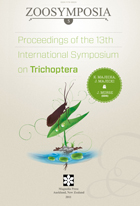Abstract
We investigated the response of caddisfly species assemblages in the middle reaches of the Shinano River to a flood that occurred in mid July 2006. Prior to the flood (on Day -22) the population density of total benthic caddisflies was 8,266.7 ± 2,392.1 individuals m-2. After the flood, by Day 11, the population density had decreased to 55.6 ± 55.6 individuals m-2. By Day 65, the density of caddis species had recovered to nearly the same level as that recorded before the flood, particularly in the case of Hydropsyche orientalis Martynov, the most abundant benthic species. By Day 65 the larvae of this species had reached pre-flood levels. On Day 40 it was noted that the larval population was dominated by final instars, but by Day 65 early instar larvae were dominant and downstream drift consisted mainly of second instars. Moreover, H. orientalis adults were constantly collected during the study period and the abundance of adults increased after Day 50. These results suggested that drift and reproduction were the main recolonization mechanisms that contributed to the rapid recovery of benthic caddisfly after the flood.

